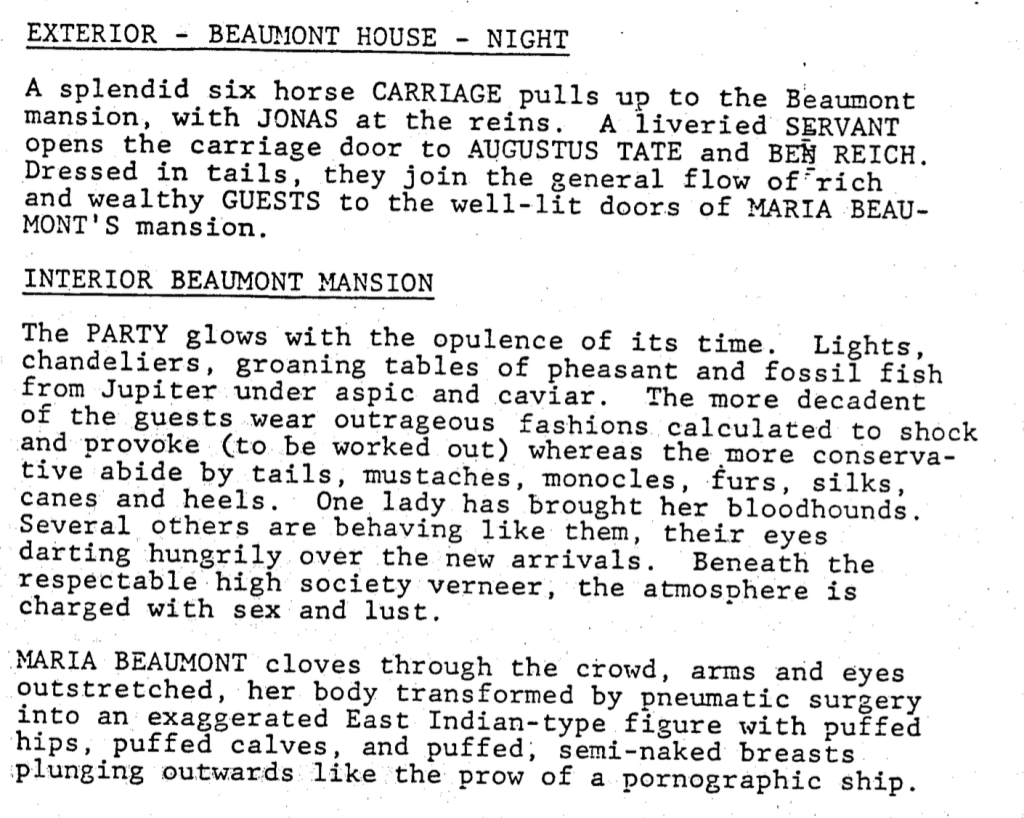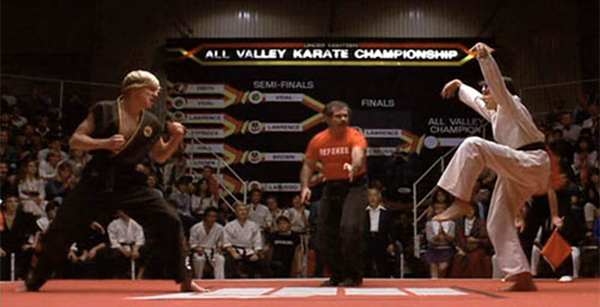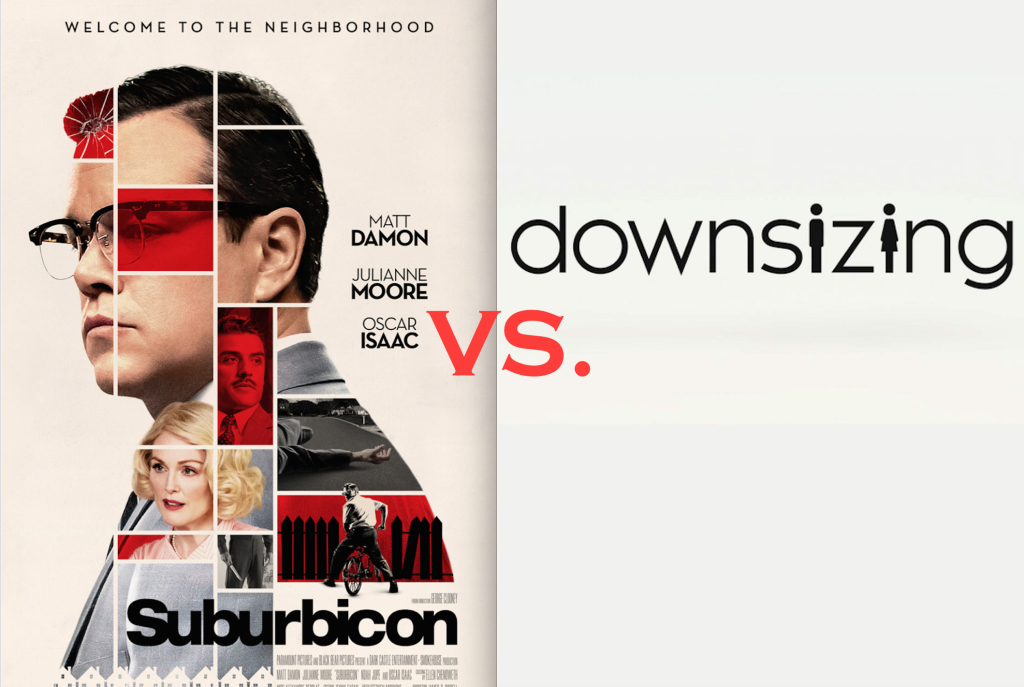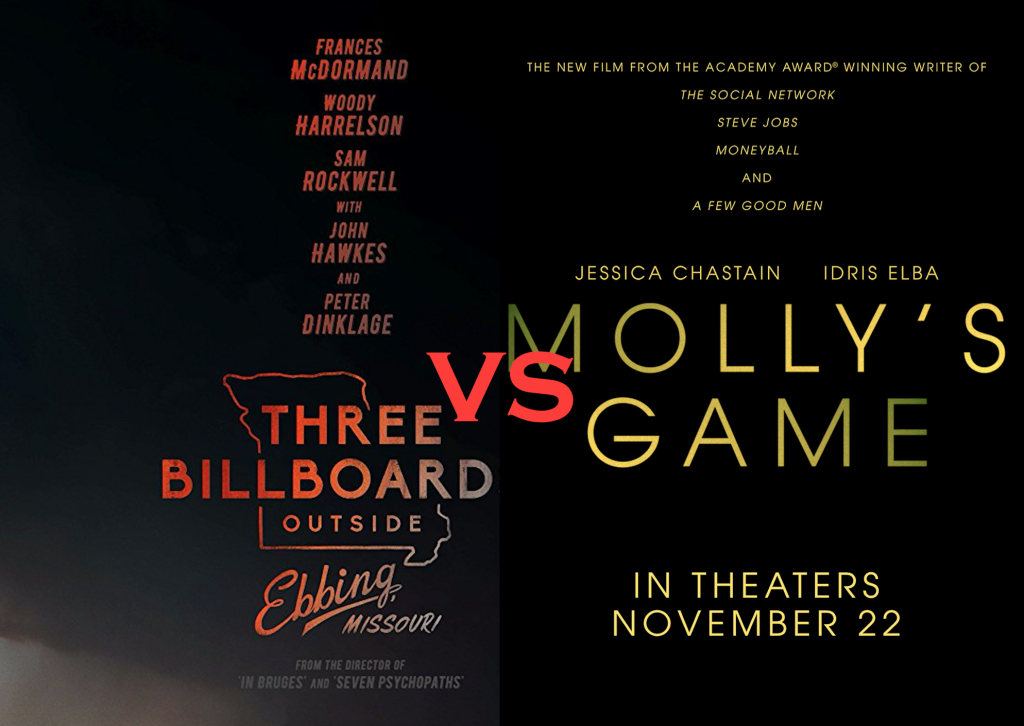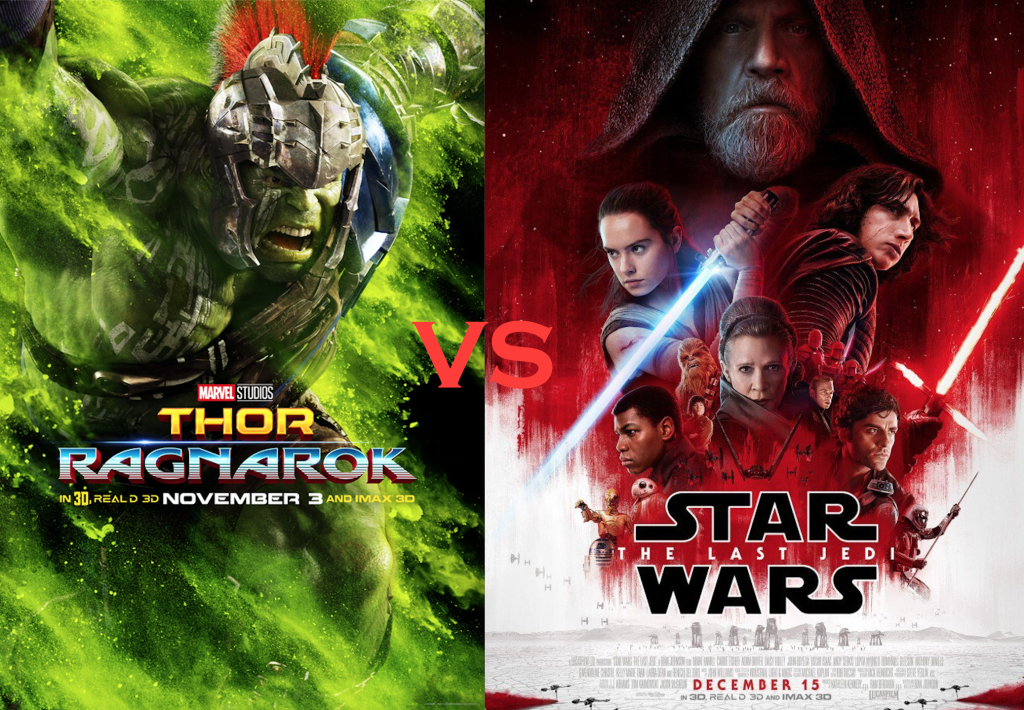Okay Sci-Fi heads. You got a wild one today. Midnight Special meets Children of Men. Who’s in???
Genre: Sci-Fi
Premise: A 16 year-old boy with special powers accidentally kills his father, forcing he and his mother to go on the run to escape authorities.
About: This script finished fairly high on the 2015 Black List. The writer, Mattson Tomlin, also had another script on The Black List that I reviewed, that one a comedy about trying to adapt a Jason Bourne movie. So this is a totally different subject matter. Tomlin is Romanian born and has written and directed a ton of short films.
Writer: Mattson Tomlin
Details: 116 pages
Have you heard? Netflix plans to release EIGHTY MOVIES next year. Eight. And then a Zero after it. 80. To give you some perspective on that, Warner Brothers, one of the major studios, released 20 movies this year. How the heck did some janky DVD rental outfit become bigger than all the Hollywood studios in under a decade?
There are a couple of ways to look at this. The first is that Netflix films aren’t very good (with a couple of exceptions). So do we really want 70 more subpar Netflix films? But for those of you reading this blog, this is AMAAAAAAAZING news. 80 films a year means anywhere from 200 to 400 screenwriters working. When you think that five years ago, this avenue didn’t even exist to screenwriters, every writer should be jumping for joy.
Speaking of, “Boy” is the exact kind of movie Netflix likes. A mid-budget genre film that’s a slightly off-center. So even though I’m going to go on one of my “sloppy screenwriting” rants after the plot breakdown, I’ll be the first to admit that these types of scripts now have an outlet.
We can tell right away that 16 year-old Mike Madnick isn’t living the typical teenage life. Sure, he goes to high school. He has a beautiful girlfriend. But Mike never goes to parties. He isn’t on any teams. He doesn’t do extracurricular activities. As soon as school is over, Mike goes home. Almost like he’s afraid of what people might find out about him.
Meanwhile, in the larger world, a new subset of people are being recognized as having a z-chromosome. This gives them special abilities, most of which revolve around mind-reading stuff, or being able to do stuff with their mind. And as cool as that is, if you happen to come out and admit you have a z-chromosome, you’re heavily discriminated against.
If you put two and two together, you’ve figured out that Mike has one of these chromosomes. And one night, after a fight with his parents, Mike sends out some sort of mind-shockwave that accidentally kills his dad. His mom, Marla, quickly buries her husband, and goes on the run with Mike.
FBI agent David Klyce becomes the point man on Mike’s case, and uses the kind of tracking abilities that’d make Tommy Lee Jones jealous, to follow Mike and Marla. Marla brings Mike to an old friend’s house, who happens to be working with the leader of an “Underground Railroad” for z-chromosomers.
However, once they team up with the Railroad, they sense that this might be less about helping Mike escape, and more about what Mike can do for them. Mother and son will have to make a decision to either trust these folks, or go back out on their own, a risky proposition with a determined Klyce on their heels.
A couple of years ago I reviewed Jeff Nichols’ screenplay, Midnight Special, which covers a lot of the same ground as Boy (a kid with special powers, on the run with his family). My problem with that script, which would go on to majorly bomb, was that the core conceit of the film – the kids powers – were vague.
He had powers but what were they? That was never clear. And when a major component (or in that case, THE major component) of your script is vague, it’s like trying to tell your story through a muddy windshield. The audience can’t see the road ahead. And if you don’t clean up the windshield at some point, they ask to get out of the car.
“Boy” is better plotted than Midnight Special. There’s more direction and clarity in the goals and stakes of the journey. But just like Midnight Special, I never got a handle on Mike’s powers. He was able to… mentally… make earthquakes? And sometimes when he got mad he was strong?
I’m not saying it’s impossible to make a script work where superpowers are vague. But you’re certainly not doing yourself any favors. The reason superhero movies are so popular is because the powers are so clear and simple. We know that when Bruce Banner gets mad, he becomes a giant green beast. We know that Spider-Man has the powers of a spider. Even superheroes with multiple powers, like Superman – the writers lay those powers out clearly (super strength, super sight, super hearing, he can fly).
The idea of a vaguely-powered character is not new. It’s been done a lot. And I think where writers go wrong with it is that they try to figure out what those powers are during the script. So they’re figuring it out at the same speed as you. You can almost sense them being like, ‘Oh yeah, they can do this.’
As the writer, you are God. You have to be all-knowing. And even if you don’t want to reveal your character’s powers right away, YOU better know what those powers are. Because there’s a difference. I know when the writer is confident about who his characters are and when he’s not. And if I sense that lack of confidence, I lose trust in the writer, and, subsequently, the story.
I’ll give you an example of both sides of the coin, since in every sci-fi review, I need to reference The Matrix. In The Matrix, they went through a painstakingly focused series of scenes to show what Neo could and could not do inside the Matrix. We understood that he had the power to move faster than others, become stronger than others, and also manipulate objects if he was really tuned in.
One of the reasons the Matrix sequels sucked was because they ditched that attention to detail. There’s that infamous moment at the end of the second film where Neo is in the gutters of the real world and the sentinels are coming for him and he throws a power wave at them, even though he’s not inside the Matrix, the only place where his “powers” exist. It was stupid. It made no sense. They never really explained it. You could point to that moment as being the nail in the coffin for the series. Once you start getting clumsy with powers and the rules that govern them, the audience gets frustrated. They stop trusting that you have a plan.
Getting back to Boy. Look, I’ve established in numerous reviews how I feel about ambiguity and vagueness. I’m of the belief that you want to be clear with your structure and the rules that govern your story, especially in sci-fi, where that kind of stuff can go south quickly. So I’m probably not the best person to judge a screenplay like this. I know that there are readers who treat ambiguity as a puzzle that allows them to participate in the story. Which I have no problem with. But for me, I can’t get past this stuff. I strongly believe that a clear set rules are imperative to a good script.
[ ] What the hell did I just read?
[x] wasn’t for me
[ ] worth the read
[ ] impressive
[ ] genius
What I learned: Think about some of the less popular superhero characters. Most of the time, it’s because you’re not clear what their power is. “Vision” in The Avengers, for example. The maroon guy with a cape. Nobody remembers him because nobody knows what the hell his powers are. Clarity is your best friend, guys. Not just in superpowers. But in all aspects of screenwriting.
Genre: Sci-Fi
Premise: In the year 2491, a Citizen Kane-like business mogul attempts to do something that hasn’t been successfully achieved in 80 years – murder a man without getting caught.
About: Before Oliver Stone became a visionary director, he was one of the most coveted writers in Hollywood. This was one of his early assignments, an adaptation of the science-fiction novel, “The Demolished Man,” the very first Hugo Award Winner (in 1953).
Writer: Oliver Stone (based on the novel by Alfred Bester)
Details: 122 pages – 1980 draft
Opening these old screenplays is a bit like opening an ancient scroll. You have no idea what you’re going to find. Another language? An entirely new screenwriting format?? Remember, this was pre-1990s, before the screenwriting market was deluged with How-To books. This meant that screenwriters took their time and wrote screenplays more like they wrote novels, with less emphasis on getting the reader in and out in 90 minutes.
It’s also nice to see a sci-fi adaptation from Stone, someone you don’t typically associate with the genre. However, as soon as you start reading “Demolished Man,” you can tell why he became attracted to the material. We have a CEO of an enormous company as our protagonist. We have money, corruption, and power. You could argue this is Wall Street in the year 2491. Let’s check it out.
Ben Reich, the CEO of Reich Industries, is a seriously wealthy man. He’s got products on Mars, on Jupiter’s moons, he’s even got an outpost at the edge of the galaxy. But Reich’s got a problem. His nemesis, Craye D’Courtney, is stealing all of his business. If he doesn’t do something soon, Reich Industries is going to be in some deep shit.
So Reich comes up with a plan. Murder Craye. That may be easy in 2017. But 2491 is a lot different. In the future, we have these people called “Espers” who have the ability to read minds. This has made murder impossible to get away with. An Esper can come in, read your mind, know you’re guilty, and it’s straight to the electric chair. Or whatever chair they use in 2491. The… laser… beam… chair?
However, Reich hires a first-class Esper, Tate, to stick with him throughout the murder and its aftermath. You see, Espers can protect against the mind-reading powers of other Espers. This allows Reich to successfully murder Craye D’Courtney at a party, and when the Esper police come by, they’re none the wiser on who did it.
One problem, though. As Reich was killing Craye, Craye’s daughter entered the room, saw the murder, and ran. So now Reich’s got a witness to the murder on the run. Which means he must find her and kill her too.
This begins a cat and mouse game between Reich and the lead Esper on the case, Liz Powell. Both of them go hunting through a grimy 2491 New York City to find this girl, a girl we learn nobody knew existed in the first place. Powell’s able to catch up with her first, but only after she’s been memory-wiped by a scientist who’s pacing her through a “regrowth” so that she can overcome the crippling shock of seeing her father killed.
Reich realizes that once the daughter regains her senses, she’s going to sing, which means Reich has to kill Powell before the daughter reboots. This forces the two sides into a showdown, where Powell recruits all the Espers to perform a mass Esper mind meld on Reich, in the hopes of stripping him of his monopolistic hold on New York, the U.S., the planet, and the solar system, for good.
I’m going to go out on a limb and say, if this is what people considered “award-winning science fiction” in 1953, Bester didn’t have much competition. I don’t think I’ve ever seen a script go south faster than this one. One second we’re engrossed in a compelling science-fiction murder investigation with tons of fresh ideas. The next we’re lost in some kind of bizarre drug-induced fever dream.
I’m talking this went from Philip K. Dick to L Ron Hubbard.
I coulda swore LSD didn’t hit the American streets until the 60s. Apparently, Bester got an early shipment. I mean, you expect this kind of stuff from Stone, who’d rather write a 20 page dream sequence than well-plotted third act. But Stone was working off material that was trippy long before he was.
Maybe it had to happen this way. This is how sci-fi began. Writers thought you threw as many ideas as you could possibly come up with into a giant novel stew and just the pure imagination of it all was satisfying to a public who had limited access to interesting ideas.
In time, we’ve learned that the “everything-and-the-kitchen-sink” approach rarely works. The best science fiction movies are simple. A clear set of rules are established early – such as being able to manipulate time and space a la The Matrix – then you spend the rest of the movie exploiting that simple rule-set.
The Esper stuff was interesting because it was a fresh way to look at murder. How do you murder someone if the detectives can read your mind? That’s a simple premise. They then exploited that premise. You solve this problem by employing a counter-Esper, someone who can block out the investigator’s powers. You’ve got a movie there.
Bester, before he went insane, also made the crafty decision to introduce the daughter into the mix. You see, if he doesn’t do that, this plot doesn’t have a purpose. The movie would be about Reich hoping the cops didn’t figure out he was the murderer. Think about that for a second. What is a character who’s “hoping something doesn’t happen” doing the whole movie? A whole lot of nothing.
Because the daughter witnessed the murder and escaped, Reich now has a goal – find and kill the daughter before she can identify him. A strong goal makes your hero ACTIVE, which gives your plot THRUST, which almost always, assuming you’ve done your job on the character end, results in an entertaining story.
Demolished Man is one of the few times this combination DIDN’T result in an entertaining story. And that’s because the writer kept throwing a bunch of random weird science-fiction shit at the story, further complicating things and taking us away from the core dramatic question – which was: would our main character get away with murder?
The daughter is captured by some scientist and reprogrammed to grow up from baby to adult in three weeks? What in the living fuch?? Reich is placed under some mind meld where one-by-one, the elements of the universe are stripped away from him until he doesn’t know which way is up? Uhhhh… are you kidding me? What happened to the story?????
That’s the key question, guys. And it’s the one you should always be asking yourself with whatever you’re writing. Am I sticking with the story? If you’re going off and screwing around with dream sequences and weird subplots that do nothing but distort the story’s purpose, you’re losing. You’re losing at screenwriting. Stay on track. Stay focused. Storytelling is simple-telling.
And one more thing. There are people who think I’m too hard on creativity. That when “challenging” material that doesn’t fit into the “proper” screenwriting paradigm like Baby Driver or Blade Runner 2049 or Upstream Color come around, I wrongly condemn them. That’s not true. I like challenging material if it’s a WELL-TOLD STORY. I loved Room. I liked Colossal. I liked Swiss Army Man. I loved Memento.
There’s a difference between mental masturbation and having a plan to tell a good story uniquely. Unfortunately, Demolished Man falls into the former category. And that’s too bad. Because it had the beginnings of a really cool film.
Screenplay link: Demolished Man
[ ] What the hell did I just read?
[x] wasn’t for me
[ ] worth the read
[ ] impressive
[ ] genius
What I learned: I’ve read about 100 scripts now with futuristic New Yorks. So I’ll give you some advice based on what I’ve found. Just making New York bigger than it is now isn’t enough. Giving New York a sprawling seedy underbelly isn’t enough. Those two things are in every single future New York I’ve read. If you’re going to write about future cities, you have to look for imaginative ways that redefine how we look at them. Try to outthink your competition. Ask yourself, “Is this thing that I’m adding something that nobody else has thought of before?” If not, keep trying. In Demolished Man’s New York, the buildings had gotten so incredibly tall, no sun reached the city anymore. It was all shadows. So they installed these giant artificial “Sun Embers” throughout the city to keep it lit during the day. I’d never seen that before. That’s the kind of imagination I want from you guys.
Get those Horror Amateur Scripts in! This Friday is Amateur Offerings: Horror Edition! E-mail carsonreeves3@gmail.com with a title, logline, genre, and why we should read your horror script – and don’t forget to include a PDF of your screenplay!
Genre: Fairy Tale
Premise: When a prince sets off on a journey with his princess-to-be to lift a spell that’s made her really boring, he discovers a shocking reality about their existence.
About: This script finished in the middle of the pack of last year’s Black List. Although she doesn’t yet have a produced credit, writer Cat Vasko parlayed this Black List showing into a seat in the Godzilla/King Kong writer’s room. How awesome is that!? Get on that Black List, guys and gals, and you could be writing inside some of the biggest franchises in Hollywood within a year.
Writer: Cat Vasko
Details: 105 pages
Writing is hard.
And one of the hardest things about it is keeping the faith.
The reason so many writers quit is because they can’t see the light at the end of the tunnel.
What they don’t realize is that if they keep writing, keep practicing, keep learning, they’re going to get better. And, at some point, their skill level is going to surpass that which is required to make it in this business.
There’s a saying I came across recently: Every fish worth catching is going to wiggle. That big breakthrough is the fish you’re trying to catch. But it’s a fighter. It’s going to fight you the whole way. Don’t give up. Cause when you finally catch it, it’s all going to be worth it.
Speaking of feeling good, I need to feel good after last night’s Cubs game. What’s up with our bullpen?? Sheesh. Time for a light and fluffy crepe of a screenplay to bring a smile to these 95 degrees in LA lips.
Winnifred is what’s known as a “Lady-In-Waiting,” which is a fancy way of saying she’s a potential princess’s servant. Her master, as it were, is a woman known as Generica, who’s currently in crisis mode as she prepares, like every other eligible lady, to try and land the studly Prince Prescott.
The thing is, Winnifred isn’t exactly Lady-In-Waiting material. She dances to the beat of her own drum, and that drum plays a song called, “Screw you guys, I’ll do whatever the hell I want.” Which is unfortunate, because it gets her fired.
That’s okay. Winnifred has always wanted to go on an adventure, and this is the perfect opportunity to follow her dream. So she wanders into a forest, gets caught in a storm, only to bump into Prince Prescott’s castle. Prescott, who’s surprisingly cool, invites her in, and immediately falls for her feisty YOLO demeanor.
Prescott’s servants like Winnifred, but she’s not refined enough to be a princess. So they bring in a “Fairy Hotmother,” to make her hot and princess-y. Unfortunately, Fairy Hotmother is new on the job and accidentally turns Winnifred into a princess drone who agrees with everything Prescott says.
Determined to rid her of this annoying quality and bring back the girl he fell for, Prescott and Winnifred travel across desert, sea, and forest to find the “Book of All Undoing,” which is the only thing that can erase the spell.
However, once they get to it (major spoiler) they learn that they are one of the Grimm fairy tales, and that they have inadvertently derailed every other fairy tale on their way here. This has caused the world of fairy tales to slowly implode, which means a simple journey about saving a princess, has turned into a story about saving the world.
I was close to writing this one off.
Everything that was happening was stuff I’d seen before. And not just once, but many times. From Enchanted to Shrek to recent spec sale, Fairy Godmother. Basic fairy tale subversion stuff.
But then, around page 60, the characters come upon the Book of All Undoing, and bump into Jacob and Wilhelm Grimm, where they learn they’ve disrupted the entire fairy tale universe.
There are couple of interesting things about this. First of all, Vasko has her main characters achieve the “big goal” by page 60. They’ve found what they’re looking for. What this does, is it creates the ultimate “Now what?” The audience has no idea where you’re going to go next, and that’s a powerful thing, when you have the audience on a string like that.
But here’s the catch. You have to have a plan in place for the script to go. I’ve read a lot of scripts that have the hero achieve their goal by the midpoint, or the 3/4 point, and they don’t have another plan in place. They don’t have a new goal to replace the old one. This leaves the last 50 pages feeling like a giant wandering mess. So, sure, you get your big “Now what?” moment. But it doesn’t matter. Cause you don’t know what’s coming next either.
Vasko introduces this secondary goal of saving the entire fairy tale universe that’s effective because it’s bigger than the previous goal. So even though we’ve solved our main script problem, we’re excited because we now have to solve an even bigger one.
I do wish this script had a little more character development though. When you’re writing fairy tales, you’re writing in the genre that invented character flaws. So you want to be big and clear with those.
For example, the only problem in Prescott’s life that I picked up on was that he felt like he was getting too old. There was a good opportunity to set up Prescott as a prince “in name only.” He couldn’t actually do any prince things because he was scared to leave the castle and be out in the real world. That way, going out on this adventure becomes more of a character-building experience, and that’s what you’re trying to do with scripts – is explore character. Build character.
But here’s an important note. Some of this was hinted at with Prescott – that he was scared to go on adventures. But it wasn’t hit on hard enough. And I see too many writers doing this with flaws. They’re way too subtle about them.
You can sometimes pull this off in more adult genres, like Drama. Those moviegoers tend to be more sophisticated and therefore can pick up on subtleties. But in comedy and fairy tales and action-adventure, you want to put flashing lights around your character flaws. Those are going to be explored in big on-the-nose ways.
The last thing I’ll say is to be careful about things that sound good in principle but are a challenge to execute. By placing this “boring” spell on Winnifred, that gives the plot purpose, since now Prescott must go on this journey to reverse the curse. However, you’re now stuck with 40 pages of a character (Winnifred) who just nods her head and says, “Whatever you please.” It takes away the best thing about Winnifred’s character, which is her personality.
I just want to remind you guys that rarely are choices black and white. For everything you gain with a choice, you’re going to lose something as well. So you want to weigh the consequences and decide if the losses are worth the gains.
But yeah, this script really surprised me with that twist, enough to reinvigorate my interest and keep me eagerly reading until the end. Which is why I thought it was worth the read. :)
[ ] What the hell did I just read?
[ ] wasn’t for me
[x] worth the read
[ ] impressive
[ ] genius
What I learned: Character names create instant images in the readers’ heads, whether you want them to or not. This is actually why so many writers go with the name “John.” It’s because they want a name that’s so generic, it doesn’t conjure any images in the reader’s head. This allows the writer to create those images for you through his character’s actions. Anyway, here, we have Winnifred. That’s a perfect name for this character. It instantly conjures up an image of a homely looking unkempt woman, which was the writer’s intention. Had Winnifred’s name been, “Lucinda” or “Kassandra,” those names evoke completely different images. So think hard about what to name your characters!
Hollywood’s favorite game is the post-weekend box office analysis. OF COURSE they knew that Movie A was going to be huge. OF COURSE they knew that Movie B was going to bomb. Not only that, but they’ve got a whole host of reasons for why a movie succeeded or failed. Rarely do you have people coming out BEFORE THE WEEKEND saying, “This movie is going to be huge” or “This movie is going to bomb.” Nobody puts their money where their mouth is since being wrong about a film’s box office in this town is akin to being videotaped kicking puppies.
Well folks, Carson don’t play that game! I’m ready to tell you what’s going to float and what’s going to sink BEFORE THE WEEKEND IS OVER. And to spice things up, I’m going to pit movies against each other. One will succeed, one will fail. Which one is the hammer? Which one the nail? Look at that. A little Scriptshadow poetry in action. As is my typical warning to anyone reading this article: Prepare to be triggered. My philistine opinions don’t always match up with the masses. You’ve been warned. Now let’s do it!
MAINSTREAM COMEDY SHOWDOWN: DADDY’S HOME 2 VS. A BAD MOMS CHRISTMAS
What. The. Fuck. I mean, seriously. I want to know who was in the room when they decided that “Christmas” would be the ideal subject matter to explore a second Bad Moms. Comedy is supposed to be IRONIC! That’s why the first movie worked so well. When people think of moms, they think nice and sweet. Not “bad.” Hence: Irony. 10,000 things come to mind when you say “Moms,” before Christmas. This is such an odd choice that I don’t even know what to say about it.
On the flip side, Daddy’s Home took what was already a good premise and elevated it. Yes, it’s true, my friends. I’m a closet Daddy’s Home fan. There are many of us out there, hiding in our minivans, afraid to come out lest we be assaulted by Goddard and Scorsese disciples for not being true cinema geeks. But Will Ferrel hasn’t found a more perfectly suited role for his talents in five years. And the choice to make John Lithgow his ever-loving uber-geeky dad? Genius.
Daddy’s Home 2: Monster Hit
Bad Mom’s Christmas: Disappointing Failure
WINNER: DADDY’S HOME 2!
MASTER VS. PROTEGE SHOWDOWN: DOWNSIZING VS. SUBURBICON
Two projects that have some crossover elements. Matt Damon is in both films. Clooney starred in Payne’s The Descendants. George Clooney really really really wants to be the third Coen brother (Suburbicon is a Coen Brothers script). He really wants to be that hip unique director a la Alexander Payne. But he just isn’t. He doesn’t have the storytelling skill or the offbeat sensibilities to pull it off. Suburbicon didn’t work when I read it and all I’ve heard since is that it’s a huge mess. Clooney needs to stop directing and utilize those gene lottery winning looks by staying in front of the camera for as long as he can get away with it.
Now Downsizing happens to be a script I didn’t like either. But Alexander Payne’s been workshopping this screenplay for a decade now and I’m going to give him the benefit of the doubt based on his past work. Downsizing is the epitome of the “strange attractor” principle we talk about so much on this site. It’s so weird and so unlike anything anybody’s seen before, I think audiences are going to show up to make this a surprise hit. Dare I say it will be Alexander Payne’s biggest hit ever.
Downsizing: Surprise Hit!
Suburbicon: Critical and Box Office Failure
WINNER: DOWNSIZING!
ASS-KICKING FEMALE SHOWDOWN: MOLLY’S GAME VS. THREE BILLBOARDS OUTSIDE EBBING, MISSOURI
Holy donkey cajones. Did I hear that Three Billboards actually won best picture at the Venice Film Festival? Either there were no other movies in contention or it was one of those classic “Eccentric Jury Member” make-ups where of course they voted a bad movie into the top prize. They had to in order to keep their “artist” street cred. This script sucked. And it didn’t even make sense. Half the time you’re wondering if it’s a true story. When you realize it isn’t, you wonder why they made it in the first place. It was just such a dumb idea. I’m guessing that whatever praise this movie receives is based on the fact that Francis McDormand is great in the role. And I’d expect nothing less from her. But even great performances can’t overcome bad scripts. And this was bad.
Meanwhile, over on Planet Sorkin, the center of the screenwriting universe, Sorkin shows how good writers actually write good scripts. Molly’s Game is a tour-de-force and it FINALLY gives the most invisible A-list actress in the world, Jessica Chastain, a role where she can break out and show what she’s made of. The only question with Molly’s Game was whether Sorkin could direct or not (this is his first directing gig) and based on the kinetic exciting trailer, my conclusion is that he did a damn fine job.
Three Billboards: Will die a quick death at the box office then fool some people into seeing it later when McDormand gets nominated. It may scrape up a few more dollars, but nobody’s going to like this enough to recommend it.
Molly’s Game: Will become a larger-than-expected hit and a big player at the Oscars.
WINNER: MOLLY’S GAME!
QUIRKY COMEDY SHOWDOWN: THE DISASTER ARTIST VS. I, TONYA
There isn’t a screenplay whose success I understood less in 2017 than I, Tonya’s. They took a made-for-tv docudrama, turned it into a feature, then added an Office-style mockumentary format? Every page was a “WTF is going on here??” moment. Bringing in the most beautiful actress working today, Australian Margot Robbie, to play an American chain-smoking puffy-faced self-described white trash queen only added to the absurdity of the project. It doesn’t bode well that Robbie admitted she had no idea this was a true story when she signed on. I don’t understand this project! Someone help me! Even scripts I’ve hated, I can still tell you why they got made. Three Billboards, for example. Great role for an actress. This one? No idea.
The Disaster Artist is the riskiest prediction I’m making today. We’re talking about a movie based on the making of a notoriously bad movie that only true cinema geeks have heard of. And because the marketing of the film is based entirely around James Franco’s depiction of the star of that infamous film, Tommy Wisseau, you wonder if anyone outside of “The Room” fans are going to get it. But I have a feeling people will respond to Franco’s weird and outlandish depiction regardless of whether they know who Tommy is or not. There’s also a really fun vibe surrounding the film. All the actors loved working on it. And whenever you have Weird Wisseau doing promotion for you, you’re going to get a few clips that go viral, indirectly selling the movie the way only Tommy Wisseau can.
I, Tonya: I don’t see how this doesn’t go straight to VOD after an initial disaster of a limited release.
The Disaster Artist: You’re not going to get Judd Apatow comedy numbers here. But I expect this movie to do decently on its first weekend and build buzz to become a surprise success.
WINNER: THE DISASTER ARTIST!
GIANT BLOCKBUSTER SHOWDOWN: THE LAST JEDI VS. THOR: RAGNAROK
The Last Jedi is in trouble. Something feels off about the film. For starters, it’s character-driven. But do we like these characters enough to drive with them? There’s a moment late in the trailer that shows Rey being tempted by the Dark Side. All I could think was, “Do I care?” Or are the fans’ online whispers about the franchise’s new protagonist true – that she’s boring? Johnson’s film looks uptight and inaccessible with its overabundance of rocky and jagged locations and simplistic color palette (everything’s RED!). There isn’t a single moment in the trailer that we haven’t seen in another Star Wars movie before. Every movie needs to give us a reason to show up. What’s the reason to show up to The Last Jedi other than “Star Wars” being in the title?
Thor: Ragnarok: Welcome to the antithesis of The Last Jedi, a space-faring adventure that actually looks fun and different. How director Taika Waititi made a Marvel movie that separates itself from both The Avengers and Guardians of the Galaxy is beyond me. But there’s a youthful enthusiasm here that seems to be lacking in The Last Jedi’s more uptight and restrained vibe. Jedi’s lone fun moment, a chicken-owl chirping on a dashboard, gives way to a dozen fun moments in Thor’s 2-minute trailer. Which do you think audiences are going to respond to better?
Predicting whether The Last Jedi will be a bomb or not means establishing studio expectations. The Force Awakens made 930 million. Rogue One made 530 million. I think Disney is looking to split the difference and is shooting for 700 million. But I’d be surprised if it makes 500, and predict something closer to 450, which would be a massive failure. Thor probably can’t reach 400, but it will get close, and has an outside chance at beating Jedi. If that happens, it would be an unheard of upset – 2 secondary superhero characters defeating the almighty Star Wars. We’ll see!
The Last Jedi: Massively underperforms
Thor: Ragnarok: Does Way Better Than Expected
WINNER: THOR: RAGNAROK!
Come on, guys. Make your own daring winter Box Office predictions below and get them on record! Don’t be a wuss and hide behind hindsight!
Genre: Period/True Story
Premise: A widowed painter travels to live with the dangerous Sioux nation in order to paint a picture of one of the most notorious and violent Indian chiefs in history, Sitting Bull.
About: The amount of time it takes to get a script into production never ceases to amaze me. Yet when you really think about it, it makes sense. After writing something good enough that people actually want to make it in the first place, you’ve got to time a number of high profile moving targets (a director and a big actor or two), all of whom are very busy, and you have to match that up with the ever-shifting sediment of the financing world. If you want to know why producers get the big money, that’s why! Steven Knight (Taboo, Allied, Peaky Blinders, the upcoming Girl in the Spider’s Web) wrote this script all the way back in 2006. It was just this year they got Jessica Chastain attached and now the film will be hitting theaters this winter on the hunt for an Oscar.
Writer: Steven Knight
Details: 115 pages – 2006 draft
In a recent article, I talked about what script trends are coming up next. One of the predictions I made was female-led period pieces. Am I Nostradamus? It’s been less than two weeks and a female-led period piece is here already!
Okay, maybe this script was written 11 years ago but it’s clear that we needed to hit this female-protagonist trend before the project got hot enough to cook its way into production. Will this lead to more of these films? Will my prediction streak continue? We’ll find out. But right now, let’s take a look at Woman Walks Ahead.
The year is 1889 and 40-something Catherine Weldon has finally moved on from the death of her husband. Catherine is a well-respected painter of portraits (she’s even painted a few senators), and one gets the impression she was afforded the luxury to become good because her now dead husband was very wealthy.
But Catherine has always longed for adventure, to paint something truly great. Her dream portrait is Sitting Bull, the great Sioux Indian Chief who lives in Standing Rock. So Catherine gets on a train and voyages to the Dakotas, where she meets James McLaughlin, a government agent who runs the local outpost there and despises Sitting Bull.
James immediately tells Catherine to turn around and go right back to where she came from. But she refuses, convincing a local Indian man to take her to Sitting Bull on the promise that she’ll use her New York connections to stop an upcoming treaty that will cut the Sioux’s land in half.
Sitting Bull, now in his 50s, is a testy little man, and refuses to be painted until Catherine offers him $1000 for his portrait. After Catherine starts painting Sitting Bull, the two form a friendship, one that will be tested when the Cut-Land-In-Half Treaty nears its signing date.
The Sioux are suspicious that Sitting Bull is cozying up to the white man. And the white men are suspicious that Catherine is sharing secrets with Sitting Bull. Basically, everybody hates that these two are BFFs, and will do anything to stop it. And by anything, I mean war.
A wonderful way to get your audience to root for your hero is to have them perform an action that’s both powerful and relatable. The very first thing Catherine does is decide to give up her safe life to do something daring and adventurous for the first time ever.
Who here doesn’t think about leaving the safety of their lives to do something bold and scary and different? We all do. Most never follow-through. But we wish we would. So when we see Catherine do this at the beginning of the story, we instantly fall in love with her. She has the courage to do something we’ve only dreamed of.
Knight then puts on a screenwriting school for the next 25 pages. Guys, I’m telling you. THIS IS HOW YOU SCREENPLAY! One of the simplest ways to keep things interesting is to MAKE EVERYTHING HARD ON YOUR HERO. If things are easy, we get bored.
The trip to the Dakotas is hard. Once Catherine gets there, she’s told to leave. Once she looks for a ride into town, her luggage is stolen. Once she gets to the Fort, James tells a soldier to arrest her and send her back on the first train. Once she gets to Sitting Bull, he refuses to talk to her. Every INCH of this journey is difficult. Every scene is difficult. This is good screenwriting, folks.
The other day we talked about how every pilot needs “THAT SCENE” – the scene that defines the show and hooks the viewer. With feature scripts, you’re looking for “THAT MOMENT.” Just like with pilots, you want that moment that’s going to hook’em. ESPECIALLY if you’re writing a slow period piece like this one, since readers are under the assumption that they’re going to be bored to death.
That scene in Woman Walks Ahead comes when Catherine first gets to the Dakotas and a local militia man, Groves, is telling her to please go home. There’s no reason for a single woman of her age to be here. She’s defiant and explains how important it is that she paint a portrait of Sitting Bull. Groves casually looks to a nearby old man. “Hey friend. Come over here.” The man walks over. “This lady here has come all the way from New York to shake hands with Chief Sitting Bull.”
The old man “takes one step forward then suddenly spits in Catherine’s face.” “Hope they fuck you then cut out the baby like they did the Robinson girls you Indian loving bitch.”
And that… is how we’re officially welcomed to Woman Walks Ahead.
Unfortunately, once Catherine actually meets Sitting Bull, all the electricity built up over the previous 40 pages becomes a lone 40 watt bulb. It’s not that their relationship is a total bust. There’s an appropriate amount of conflict early on to keep things interesting. But once that dissipates and the two actually start liking each other, it all becomes rather… boring.
You could almost hear Steven Knight dreading this section in his head. “How the hell am I going to make this work?” It’s a big challenge to keep an appropriate amount of tension between two characters sharing every scene for an extended period of time. You need variation in the plot to stir shit up. And while there was the whole treaty thing, it wasn’t nearly as shit-stirring as it needed to be to keep things entertaining.
The script does have an unexpected and powerful ending. And the relationship between Catherine and Sitting Bull went further than I expected it to. Still, that slow-motion middle section was a hefty price to pay – some might say the equivalent of $1000 – to get to the rewarding finale.
The unspoken screenwriting problem with these movies – and with any team-up movie really – is that you can’t have the characters hate each other the whole time. There has to be some connection. But when they connect, it isn’t as interesting. So you’re stuck trying to walk this line between conflict and happiness, two terms that contradict one another.
With that said, I expect to see more of these female-led true story period pieces getting purchased. So if you write in that genre, now’s the time to capitalize. Just make sure that your lead female role is Oscar-worthy. This movie doesn’t work if it’s set in 1968 and Catherine is painting Jimmy Hendrix. It had to be a time when a woman traveling alone into dangerous Indian territory was a death-sentence. That’s the kind of thing that both actresses and Academy voters are attracted to.
[ ] What the hell did I just read?
[ ] wasn’t for me
[x] worth the read
[ ] impressive
[ ] genius
What I learned: Character decisions need to come with consequences! Catherine leaving to paint Sitting Bull had major consequences. Her dead husband’s parents told her, we will disavow you. You won’t be able to come back here or have our money anymore. That’s a way more powerful moment than if they paid her way and told her they couldn’t wait til she came back so they could hear her stories over hot cocoa.



